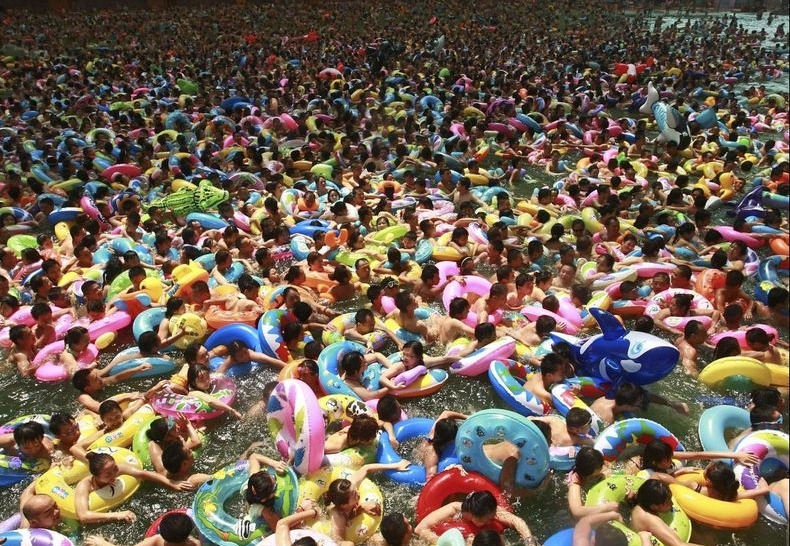Bather Loads, Pollution, Turnover...It's All Relative.
Posted by poolplantcourses.com on Friday, August 26, 2016 Under: Pool Water Pollution

Relative Pollution
A pool that is 25 metres long, 12 metres wide, with an average depth of 1.5 metres will hold 450 cubic metres of water. If there are, say, 30 people in the pool, each of them will have 15 cubic metres of water each.
Contrast this situation with a spa pool. A spa will only hold about 3 - 10 cubic metres of water, depending on the type. Let's say we have a spa pool that holds 5 cubic metres and has 10 people in it. Each person now has only half of one cubic metre of water each.
Even though there are more people in the swimming pool (and therefore more total pollution), the relative pollution is higher in the spa due to the fact that as a percentage of volume, the pollution levels are higher. The spa is said to have higher relative pollution levels. Spa pools are not the only types of pool that suffer from high relative pollution. Any pool that has an unfavourable pollution to water ratio will also have high relative pollution. Examples are:
• paddling pools
• splash zones
• teaching pools
• hydrotherapy pools
Bather Load and Turnover Period
The more bathers in a body water (bather load), the more pollution will be introduced (all other factors being equal) and the more important it will be to get rid of the dirty water and introduce fresh water quickly. This is achieved via circulation of the water and the time it takes to move water around the system is an important factor in maintaining good water quality. The quality of the pool water will deteriorate the longer it takes to circulate the water around the system.
Bather Load
It is important that pool operators do not over load a pool with bathers. It makes it difficult for lifeguards to spot people in trouble and it also has a negative impact in the quality of the pool water.
Pool operators need to establish two different types of bather load:
1. Instantaneous bather load
2. Total daily bather load
In order to calculate the instantaneous bather load, the following formulae should be used:
• For water that is under 1.0m deep, each swimmer should have 2.2m2 of surface area each
• For water that is 1.0 – 1.5m deep, each swimmer should have 2.7m2 of surface area each
• For water that is over 1.5m deep, each swimmer should have 4m2 of surface area each
As an example, for a swimming pool that is:
• 20m long;
• 12m wide;
• with a deep end that is 2.0m deep and ;
• a shallow end that is 1.0m deep…
…the bather load would be calculated as follows:
• Shallow End: 10m x 12m / 2.2m = 55 bathers
• Deep End: 10m x 12m / 4.0m = 30 bathers
The total instantaneous bather load for the whole pool would therefore be 85 bathers at any one time.
In order to calculate the total daily bather load the following formula should be used:
• Instantaneous bather load x 25 – 50% x 12
As an example for the same swimming pool as above:
• 85 x 25 – 50% x 12 = 255 - 510 bathers per day.
Pool operators should only go to the upper end of this range if they are confident that the pool plant system can handle it and maintain good water quality. If in doubt, the advice would be to stay in the bottom half of the range.
Turnover Period
In order to achieve the correct turnover period, the circulation pumps need to be pumping water around the system quickly enough. The rate at which the water is moving around the system is called the flow rate. A rough guide when designing and sizing swimming pool circulation systems is to multiply the instantaneous bathing load (referred to earlier) by 1.7 to give a target flow rate to aim for. Therefore, using the example from earlier, the target flow rate can be calculated as follows:
• 85 x 1.7 = 144.5 m3/hr
Pool operators should ensure that the pool water is being circulated quickly enough by establishing and documenting the turnover period, that is; the amount of time it takes to for a volume of water equal to the pool volume, to pass through the system. This is done by dividing the pool volume by the flow rate. The flow rate is simply the rate of flow of pool water through the system, usually expressed as cubic metres per hour (m3/hr). See the worked example below:
• Pool Volume - 300m3
• Flow Rate - 144.5 m3/hr
• Turnover Period - 2 hours
In : Pool Water Pollution
Tags: "bather loads" "relative pollution" "turnover"
